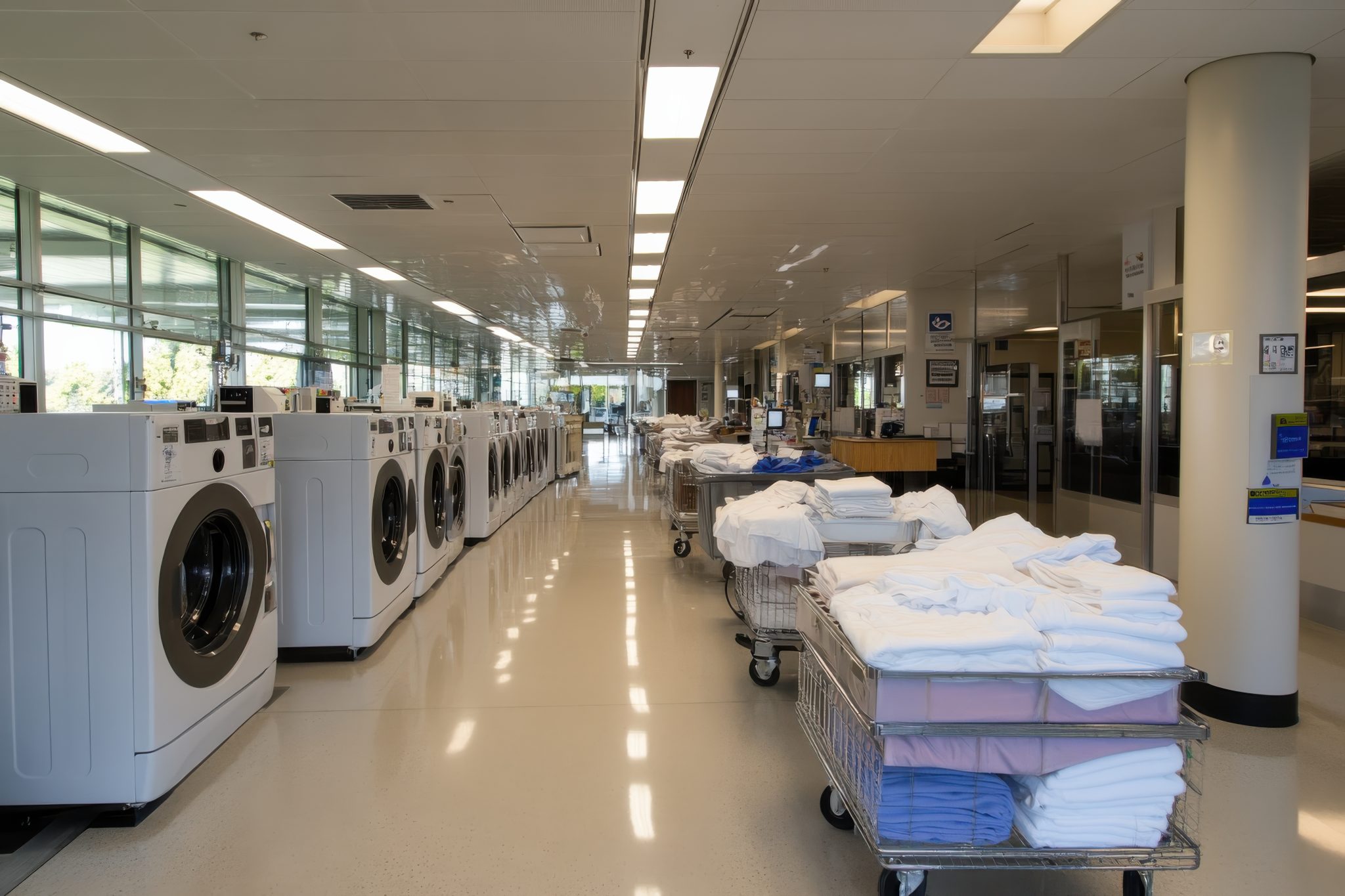Introduction
From its early beginnings in communal washhouses to modern, technology-driven facilities, the laundromat industry has undergone significant transformations. Today, the “laundromat” conjures visions of neat rows of coin-operated machines, neon signs, and the hum of spinning washers and dryers. But behind this relatively simple concept lies a rich history that reflects both broader technological advancements and shifts in social and economic patterns across the 20th and 21st centuries. This article traces the origins, growth, and future of the laundromat industry, offering an in-depth look at how the concept of self-service laundry became a cornerstone of modern urban life.
1. Early Roots of Public Laundry
1.1 Communal Washhouses in Antiquity
Long before the modern notion of the laundromat emerged, communities around the world relied on public washhouses or common streams where people gathered to wash clothes by hand. These gatherings were often central to social life—friends and neighbors would share news, gossip, and experiences. Although the facilities varied by region, from open-air watercourses in Europe to the banks of rivers in Asia and the Americas, the common element was the social dimension of laundry day.
1.2 The Rise of Public Washhouses in the 19th Century
As cities grew rapidly in the 19th century—spurred by the Industrial Revolution—public washhouses were established as a response to crowded urban living conditions. In parts of Europe, municipal authorities constructed these facilities to improve public health and sanitation. Some of these washhouses started to incorporate basic mechanical aids, such as hand-operated wringers and rudimentary washing mechanisms powered by hand cranks. These early mechanized elements foreshadowed the more sophisticated laundry machines that would emerge in the decades to come.
2. The Advent of the Washing Machine
2.1 Patent Beginnings
The seeds of the laundromat industry were planted in the mid-to-late 19th century with the invention of the first mechanical washing machines. Patented devices—like James King’s hand-powered washing machine in 1851—represented a significant step toward efficiency. However, these machines were generally large, unwieldy, and still required manual labor to operate. It wasn’t until the late 19th and early 20th centuries that electric motors began to revolutionize home appliances, washing machines among them.
2.2 Electric Washing Machines
In the early 1900s, electric washing machines started appearing, but they were expensive and not widely adopted for domestic use. As manufacturers such as Maytag, Whirlpool, and others refined their designs, electric washing machines became more reliable, though still considered a luxury item. Households that could afford one were early adopters, while others continued to rely on communal or manual methods.
3. Birth of the Self-Service Laundry Concept
3.1 The First Laundromat (1930s)
The concept of a “self-service laundry” began to take shape in the early 1930s. Often cited as the first official laundromat, a facility in Fort Worth, Texas, opened around 1934 under the name “Washateria.” Customers could bring in their laundry, pay a fee, and use available electric-powered washing machines. Though this early iteration did not yet adopt a fully coin-operated model, it established the concept of multiple washing machines available for the public to operate themselves.
3.2 Coin-Operated Mechanisms
By the late 1930s, entrepreneurial-minded individuals began to experiment with ways to automate the payment system. Coin-operated machines had been introduced in various forms for vending products—cigarettes, candy, and so on—since the 1880s. Adapting the concept for laundry machines involved engineering a reliable coin mechanism that could control access to the machine’s wash cycle. This innovation paved the way for the true “coin laundry” or “laundromat.”
3.3 The Term “Laundromat”
While “Washateria” was an early commercial term, “laundromat” soon gained popularity. The term is believed to have been coined to evoke cleanliness (“launder”) and a sense of automatization (“-mat,” as in “automat”), reflecting the self-service component. By the 1940s, “laundromat” and “coin laundry” were nearly synonymous in the public mind.
4. Wartime and Post-War Expansion
4.1 World War II Influence
The laundry industry, like many others, was impacted by the constraints and social changes of World War II. Factories that produced washing machines diverted materials to the war effort. Meanwhile, growing numbers of women entered the workforce, leaving less time for labor-intensive household chores such as laundry. This shift created greater demand for public facilities where laundry could be done more efficiently.
4.2 The Boom of the 1950s
After World War II, the United States (and other countries experiencing economic booms) saw a rapid rise in suburban growth and disposable income. Home ownership of electric washers and dryers became more common. However, urban centers continued to expand, and apartment living often lacked space or the infrastructure for private washers and dryers. This created a sustained demand for self-service laundry facilities. Coin laundries proliferated, becoming fixtures in neighborhoods across North America, Europe, and beyond.
5. Industry Growth, Branding, and Diversification (1950s–1970s)
5.1 The Golden Age of Coin Laundries
In the 1950s and 1960s, laundromats transitioned from small, single-owner operations to standardized businesses with rows of coin-operated washers and dryers. Some entrepreneurs began to branch out, opening multiple laundromats under a single brand or chain. These expansions were facilitated by:
- Improved Machine Technology: Manufacturers were producing more durable machines designed for heavier, commercial usage.
- Consumer Familiarity: By this time, self-service laundry was a well-established concept; there was little need to educate customers on how to use the machines.
- Low Overhead: Compared to other retail businesses, laundromats generally required less staffing, reducing labor costs and increasing profitability.
5.2 Additional Services and Amenities
As competition grew, laundromat owners experimented with ways to stand out. Some offered drop-off services, where customers could leave their laundry to be washed, dried, and folded by an attendant. Others introduced vending machines selling laundry detergent, snacks, and beverages, blurring the line between a purely utilitarian location and a more social, convenience-oriented space. Some laundromats even expanded into hybrid models—for example, combining a laundromat with a café, bar, or internet lounge.
5.3 Technological Advances
Machine technology also improved during this era. Mechanisms for coin operation became more reliable, and washing machines were built with larger capacities and faster spin cycles. Dryers became more energy-efficient, though energy costs continued to be a significant expenditure for laundromat operators.
6. Challenges in the 1980s and 1990s
6.1 Competition from Home Appliances
During the 1980s and 1990s, home washing machines and dryers became more affordable. Many new apartments and homes included in-unit laundry machines, reducing the consumer base for laundromats. This led some industry observers to predict a decline in self-service laundry.
6.2 Changing Demographics and Urbanization
While suburbanization pulled potential customers away, urban centers continued to attract populations that needed laundromats—students, low-income households, and young professionals living in apartments without washer/dryer hookups. In some cities, gentrification also prompted landlords to install laundry rooms in renovated buildings, yet demand for laundromats remained consistent in areas with large transient or rental populations.
6.3 Recession and Industry Consolidation
Economic fluctuations in the late 1980s and early 1990s had a mixed impact on laundromats. On one hand, owners faced challenges like higher energy costs and competition. On the other, economic downturns often led to an uptick in the rental market and thus more people needing self-service laundry facilities. Many smaller laundromats were bought out or consolidated by larger operators looking to streamline costs and standardize operations.
7. Technological Transformation (2000s–Present)
7.1 Card-Operated and Digital Payment Systems
One of the biggest changes in the early 21st century was the shift from coin-operated machines to card-operated systems. Instead of lugging around quarters, customers could purchase or recharge a laundry card, swiping it to start washers and dryers. In recent years, smartphone apps and contactless payments have further modernized these systems, offering customers the convenience of paying with a phone or credit card.
7.2 High-Efficiency Machines and Sustainability
Manufacturers responded to growing concerns about water and energy usage by producing high-efficiency front-loading washing machines. These machines use less water, heat more efficiently, and can handle larger loads, thereby reducing operational costs in the long run. Many laundromats have upgraded their fleets to these machines to remain competitive and appealing to environmentally conscious customers.
7.3 Enhanced Customer Experience
Recognizing that customers spend a considerable amount of time waiting for their laundry, many modern laundromats have redesigned their facilities to be more inviting. Comfortable seating, Wi-Fi access, charging stations, TVs, or even on-site cafés are increasingly common. Some laundromats have become multi-purpose community spaces, hosting live music, art exhibits, and other events.
8. The Global Perspective
8.1 Rapid Urbanization in Emerging Markets
While coin-operated laundromats are strongly associated with North America and parts of Western Europe, they are also expanding globally. In emerging markets—especially in Asia and Latin America—rapid urbanization and a growing middle class create a demand for convenient laundry solutions. In some densely populated regions, space constraints make in-home washer/dryer setups infeasible, driving more people to commercial self-service facilities.
8.2 Cultural Adaptations
In countries where laundry has traditionally been done at home or through domestic workers, laundromats must adapt marketing strategies and cultural perceptions. For example, in some parts of Asia, communal laundry services are customarily run by family-owned businesses offering additional services like pressing and folding. Adapting the coin-laundry model to local preferences and financial systems can be challenging, but it has proven a viable option in urban centers where young professionals are short on time.
9. The COVID-19 Pandemic and Recent Trends
9.1 Essential Business Status
During the COVID-19 pandemic, laundromats were widely deemed essential businesses, allowed to stay open to ensure access to clean clothes and linens—critical for public health. This underscored the role laundromats play in communities, particularly in low-income or high-density housing areas.
9.2 Shift Toward Contactless Services
Health precautions during the pandemic accelerated the adoption of digital payment and remote monitoring apps. Customers and operators sought to minimize physical contact, further driving the trend away from coin-operated systems. Many laundromat owners also embraced online reservations or scheduling systems, allowing customers to secure machines in advance and reduce wait times.
9.3 Pickup and Delivery Services
Another trend that gained momentum during the pandemic is the expansion of pickup and delivery laundry services. While not a strictly self-service model, many laundromats saw an opportunity to diversify by offering convenient drop-off, wash-and-fold, and delivery. This helped laundromats remain competitive against on-demand laundry service startups.
10. The Future of Laundromats
10.1 Technology Integration
Looking ahead, laundromats are likely to continue integrating technology to enhance customer experience and streamline operations. Possible advancements include machines that sync with smartphone apps, automated alerts when laundry cycles are complete, and “smart” washers and dryers with real-time diagnostics to reduce downtime.
10.2 Environmental Considerations
As global focus on sustainability intensifies, laundromats may adopt more eco-friendly operations. This could include installing solar panels, using water recycling systems, and opting for machines with advanced energy-saving features. Governments in many regions offer incentives or mandates aimed at reducing water and energy consumption, driving further innovation.
10.3 New Business Models
Operators may seek to reinvent laundromats as multi-purpose spaces that cater to convenience and community needs. Examples include laundromats that double as coworking spaces, gyms, or even bars. These creative hybrids aim to reduce the perceived “wasted” time spent waiting for laundry cycles and transform the chore of laundry into a more social or productive endeavor.
Conclusion
From rudimentary washhouses to fully automated, tech-driven facilities, laundromats have evolved to meet the changing needs of society. The core concept—providing a shared space equipped with specialized machines—has remained consistent, while the details have shifted dramatically with advances in technology and changing social norms. The laundromat stands as a testament to how everyday tasks like washing clothes can adapt to innovation, economic forces, and cultural shifts.
Despite challenges ranging from the rise of in-home appliances to global pandemics, laundromats continue to serve an essential function: offering convenient, affordable, and communal laundry services to millions around the world. And as they embrace the latest waves of technology and consumer demands, laundromats are poised to remain a vital presence in urban landscapes for generations to come.








